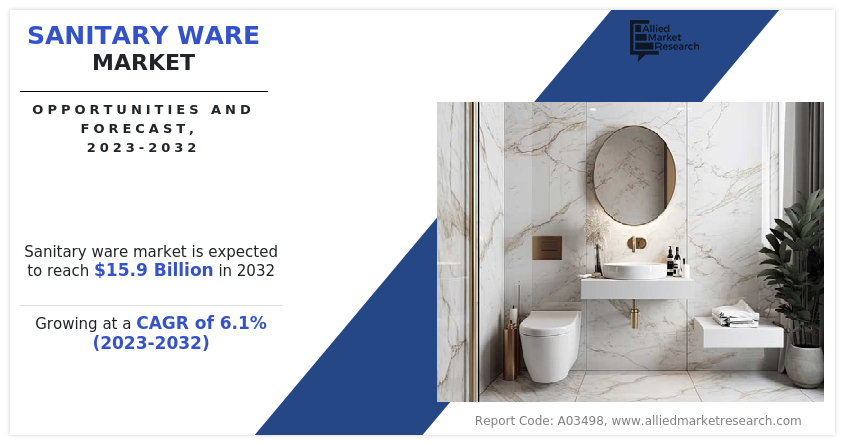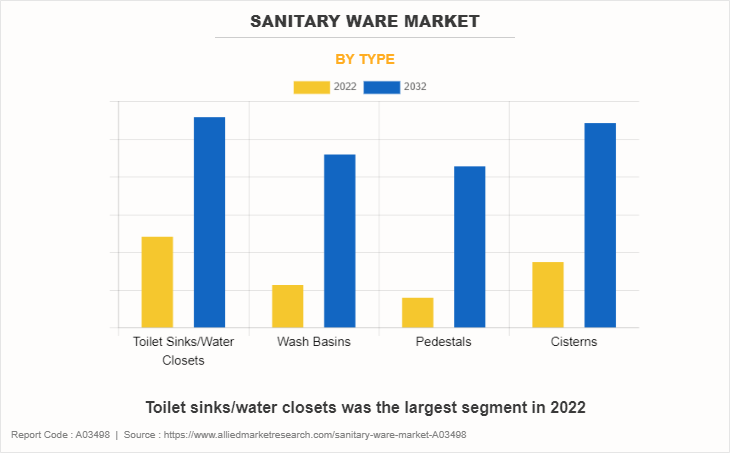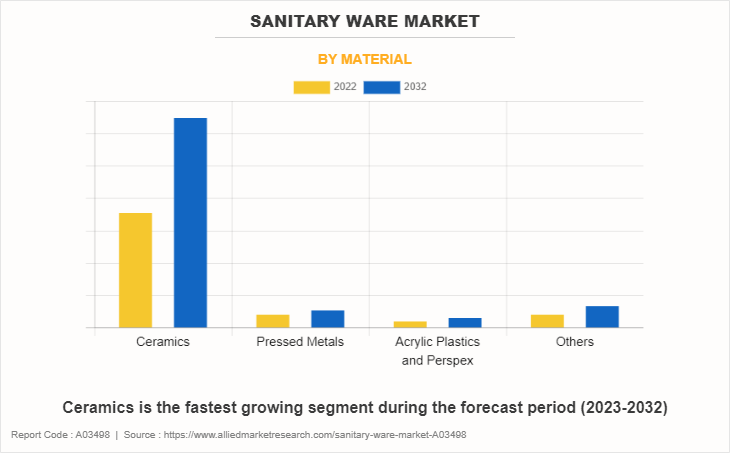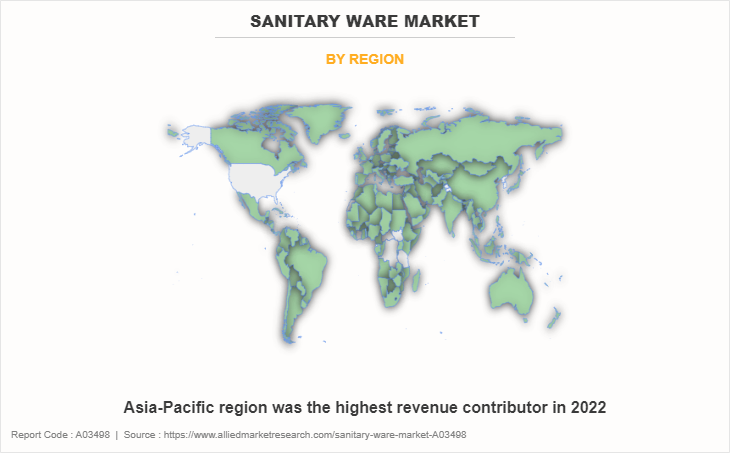Sanitary Ware Market Overview, 2032
The global sanitary ware market size was valued at $9 billion in 2022, and is projected to reach $15.9 billion by 2032, growing at a CAGR of 6.1% from 2023 to 2032. A variety of bathroom accessories and fittings that are intended for sanitation and hygiene are referred to as sanitary ware. It contains necessary components like sinks, bidets, bathtubs, and showers. Due to these products' long lifespans, ease of maintenance, and moisture resistance, materials like ceramic, porcelain, or vitreous China are frequently used in the manufacturing process of sanitary ware. Sanitary wear is a crucial component of every bathroom, adding appealing and attractive features to the bathroom and toilet. Traditional, wall-hung, and corner toilets are a few of the different styles available for toilets, while pedestal, wall-mounted, and countertop sink options are available for sinks. While baths and showers give alternatives for relaxation and cleaning, bidets improve personal hygiene. Sleek designs, water-saving features, and user-friendly innovations are common elements of contemporary sanitary equipment, which frequently mixes aesthetics with practicality.

MARKET DYNAMICS
Construction and renovation operations are crucial for sustaining economic growth and stability, which in turn boosts the need for sanitary ware items. The sanitary ware market is being driven by a growing middle class and higher discretionary budgets as more individuals in emerging countries want to remodel their bathrooms with modern fixtures. On the other hand, economic recessions can lead to decreased consumer spending and less investment in home improvement initiatives, which can have a negative impact on the sanitary ware market growth.
The sanitary ware market is changing owing to advancements in technology. Bathroom fixtures with connectivity and intelligence are growing in popularity. These products come with attributes like touchless operation, water and energy efficiency, and smartphone compatibility. Modern materials, such as self-cleaning ceramics and antimicrobial surfaces are also being included in sanitary wear to improve hygiene and longevity. These technology developments support customer convenience preferences while simultaneously promoting sustainability and water saving. The growing importance of environmental consciousness and sustainability is driving demand for eco-friendly and highly efficient products in the sanitary ware market. Water-efficient devices like low-flow toilets and water-saving faucets are in high demand particularly in regions where there are concerns about water shortages. Manufacturers are under pressure to create recyclable, environment-friendly, and low-impact products. Environmental standards and water consumption certificates issued by the government have a further impact on product design and production.
The sanitary ware market is affected by changing demographics in several ways. The need for senior-friendly toiletries like grab bars, walk-in tubs, and elevated toilets has surged owing to aging population, particularly in developed nations. However, new construction initiatives and urban apartment developments are being driven by urbanization and an increasing global population, which is fostering market expansion. The market offers a vast selection of designs, materials, and customizability options to suit different tastes and preferences. There is a resurgence of interest in antique and retro designs in addition to modern and minimalist ones. Customers are determined to spend money on sanitary items that go well with their bathroom design and aesthetic preferences.
The sanitary ware market has a lot of potential to grow in the emerging markets of South America, Africa, and Asia. The demand for bathroom fixtures and fittings is rising in these areas due to fast urbanization and changes in living standards. The established firms and new establishments that manufacture sanitary ware products are working together to meet the rising demand for the products.
In addition, online platforms provide ease, a large selection of product choices, and frequently competitive costs. The online platforms help consumers to do product research and compare different products as compared to traditional brick-and-mortar stores. The higher availability of quality products at a discounted price makes online channels a popular medium of sales for sanitary ware products in the sanitary ware market.
The COVID-19 pandemic has made sanitation and hygiene more important all around the world. This has surged the demand for sanitary ware products in the global sanitary ware market. Consumers are becoming more interested in touchless fixtures and antimicrobial surfaces that are less prone to contamination and require less maintenance. Customers are looking for products that showcase their distinct interests and styles. As a result, producers are providing more options for customization, enabling people to design unique bathrooms. From color selections and finish options to distinctive design features, customization includes a variety of characteristics.
With the use of standards and regulations, governments have a significant impact on the sanitary ware market. Water use, safety, and environmental impact are all covered by these standards. For their products to be compliant, manufacturers must abide by certain requirements. It is projected that water efficiency and product durability rules will become stricter as governments throughout the world place greater emphasis on sustainability and resource conservation. So, several dynamic elements that affect consumer preferences, product innovation, and market expansion are present in the sanitary ware market. The future of the sanitary ware market will also probably continue to change as a result of continuous environmental initiatives and innovations in technology.
SEGMENTAL OVERVIEW
The global sanitary ware market is analyzed on the basis of type, material, and region. By type, the market is divided into toilet sinks/water closets, wash basins, pedestals, and cisterns. By material, the market is segmented into ceramics, pressed metals, acrylic plastics and Perspex, and others. Region wise, the sanitary ware market is analyzed across North America (the U.S., Canada, and Mexico), Europe (Germany, the UK, France, Italy, Spain, Poland, and the rest of Europe), Asia-Pacific (China, India, Japan, Thailand, Vietnam, Indonesia, and the rest of Asia-Pacific), and LAMEA (Brazil, Argentina, South Africa, Saudi Arabia, and the rest of LAMEA).
BY TYPE

As per type, the toilet sinks/water closets segment dominated the global sanitary ware market in 2022 and is anticipated to maintain its dominance throughout the sanitary ware market forecast period. Sustainability and efficiency are the prevailing trends in the market for toilet sinks and water closets. Toilets with reduced water usage and dual flushes are becoming more common. Space-saving options and a contemporary look are provided by wall-mounted toilets. Technologies for self-cleaning toilets save maintenance while touchless and sensor-activated fixtures encourage hygiene. Models with clean, simple lines and configurable features are in demand from a design perspective. Furthermore, the popularity of smart toilets is growing, many of which have features like heated seats and bidet functions.
BY MATERIAL

The ceramics segment dominated the global sanitary ware market in 2022. A growing tendency toward ceramics as a preferred material is being seen in the market for sanitary ware. Due to its strength, simplicity of maintenance, and enduring aesthetic appeal, ceramic sanitary ware is highly desired. Ceramic production innovations have produced svelte, thin-profile designs that are both visually beautiful and appealing. Furthermore, there are antibacterial characteristics in ceramic materials to satisfy growing hygiene concerns. The growing demand for sustainable products is driving ceramic sanitary ware market demand.
BY REGION

Region wise, Asia-Pacific is predicted to dominate the sanitary ware industry with the largest sanitary ware market share during the forecast period (2023-2032). Due to environmental concerns and challenges with water shortages, there is an increasing demand for items that are both eco-friendly and water efficient. Customers looking for automation and convenience are buying smarter bathroom fixtures. Demand for senior-friendly designs is being driven by an aging population. A further factor driving up demand for contemporary, space-saving bathroom solutions is the region's growing urbanization. While governmental rules and hygiene considerations continue to determine the market's environment, emerging markets in the Asia-Pacific region offer sanitary ware producers’ substantial potential opportunities.
COMPETITION ANALYSIS
The key players in the sanitary ware industry are Geberit AG, LIXIL Group Corporation, Jaquar Group, LAUFEN Bathrooms AG, CERA Sanitaryware Limited, Kohler Co., TOTO Ltd., Masco Corporation, Elkay Manufacturing Company, and Hindware Homes by HSIL Limited.
Market leaders from around the world, regional competitors, and upcoming brands are all combating market share in the highly competitive market. Innovation, design, pricing, distribution, and the capacity to meet changing customer desires including sustainability and hygiene are important competitive forces.
SOME EXAMPLES OF KEY DEVELOPMENTS IN THE MARKET
- In February 2022, Kohler Co. announced the construction of the Greenfield Plumbing Ware manufacturing facility in Casa Grande, Arizona, to offer more products through its brands, including sanitary ware products.
- In March 2020, Jaquar Group opened its new flagship Jaquar World showroom in Moscow at Leninsky Prospekt 85 to increase its consumer base.
- In June 2023, Toto Ltd. launched NEOREST WX, the ultimate wall-hung toilet model, to offer peace of mind, comfort, and relaxation in bathrooms for its customers.
- In January 2022, Villeroy & Boch AG launched the collection of the washbasins that come in three shapes for three installation types: round, oval and rectangular, and available as surface-mounted, built-in and undercounter models for its customers.
Key Benefits For Stakeholders
- This report provides a quantitative analysis of the market segments, current trends, estimations, and dynamics of the sanitary ware market analysis from 2022 to 2032 to identify the prevailing sanitary ware market opportunities.
- The sanitary ware market research is offered along with information related to key drivers, restraints, and opportunities.
- Porter's five forces analysis highlights the potency of buyers and suppliers to enable stakeholders make profit-oriented business decisions and strengthen their supplier-buyer network.
- In-depth analysis of the market segmentation assists to determine the prevailing market opportunities.
- Major countries in each region are mapped according to their revenue contribution to the global market.
- Market player positioning facilitates benchmarking and provides a clear understanding of the present position of the market players.
- The report includes the analysis of the regional as well as global sanitary ware market trends, key players, market segments, application areas, and market growth strategies.
Sanitary Ware Market Report Highlights
| Aspects | Details |
| Market Size By 2032 | USD 15.9 billion |
| Growth Rate | CAGR of 6.1% |
| Forecast period | 2022 - 2032 |
| Report Pages | 250 |
| By Type |
|
| By Material |
|
| By Region |
|
| Key Market Players | LIXIL Corporation, Zurn Elkay Water Solutions Corporation, Villeroy & Boch AG, Masco Corporation, Toto Ltd., Kohler Co., Laufen Bathrooms AG, Cera Sanitaryware Limited, Geberit International AG, Jaquar Group |
Analyst Review
The perspectives of the leading CXOs in the sanitary ware industry are presented in this section. Various products necessary for kitchen and bathroom fixtures are included in the market for sanitary ware. The market has been shaped recently by a number of notable trends. Sustainability and eco-friendliness are becoming increasingly important among consumers. Environment-friendly products like water-saving fixtures are gaining popularity in the global market. In addition, the incorporation of smart technologies is transforming the sanitary ware market. Convenience and hygiene are improved through touchless sensors, smart toilets, and voice-activated features, which are growing in popularity.
The market is divided into organized and unorganized players. The organized players have a stronghold in the market, and hence, they pose a strong entry barrier for the new entrants in the market. The brand creation in this market takes more than five to ten years. The creation of a strong and widespread distribution network is a constant and long-drawn process. It takes many years to create such a network, and thus, this network creation is a strong entry barrier. In addition, the investment cost is very high in the sanitary ware market. The players in the organized sector benefit because of their strong brand image and the existing distribution network in the sanitary ware market.
The global sanitary ware market was valued at $9,022.7 million in 2022, and is projected to reach $15,918.6 million by 2032, registering a CAGR of 6.1% from 2023 to 2032.
The forecast period in the Sanitary ware market report is 2023 to 2032.
The base year calculated in the Sanitary ware market report is 2022.
The top companies analyzed for the Sanitary ware market report are Geberit AG, LIXIL Group Corporation, Jaquar Group, LAUFEN Bathrooms AG, CERA Sanitaryware Limited, Kohler Co., TOTO Ltd., Masco Corporation, Elkay Manufacturing Company, and Hindware Homes by HSIL Limited.
The toilet sinks/water closets segment is the most influential segment in the Sanitary ware market report.
Asia-Pacific holds the maximum market share of the Sanitary ware market.
The company profile has been selected on the basis of key developments such as partnership, product launch, merger and acquisition.
The market value of the Sanitary ware market in 2022 was $9,022.7 million.
Loading Table Of Content...
Loading Research Methodology...



